Port Saint-Sauveur, time to modernise the Canal du Midi
Port Saint-Sauveur in Toulouse was created in 1830 to support the nearby Port Saint-Etienne that had become too small to accommodate all the boats.
Port Saint-Sauveur was where goods were loaded and unloaded back then. It was also home to other businesses in connection with the Canal du Midi, such as the carpenters who were responsible for repairing the boats.
Port Saint-Sauveur was part of an initiative to modernise the Canal du Midi in 1830
Port Saint-Sauveur or the extension of Port Saint-Etienne
At the beginning of the 19th century, transport along the Canal du Midi was developing very quickly.
Faced with a booming inland waterway and trade industry, Port Saint-Etienne was no longer capable of accommodating all the business generated by the Canal du Midi.
Upstream of Port Saint-Etienne, a bend in the canal was progressively being transformed into a place for boats to moor. Skippers had taken on this habit to avoid the high taxes associated with mooring their boat at Port Saint-Etienne.
Under pressure from merchants and skippers, it was decided to extend Port Saint-Étienne just before the French Revolution.
Jean Polycarpe Maguès and his son Urbain Maguès were entrusted with the project to extend the official Port Saint-Etienne, between 1827 and 1830. As such, the canal route was modified and the bend was removed so that boats could be moored more easily. One hundred and fifty metres of docks were built, and this area was named Port Saint-Sauveur.
A port for the accelerated service
The creation of Port Saint-Sauveur came at the same time as the creation of a special transport service, the accelerated navigation service.
Why was that? Because in the 19th century, the improvement of roads and cross connections made the shipping of goods using other means much faster, and so the barques de poste (boats transporting passengers) were faced with fierce competition.
Accelerated navigation meant that goods and passengers could get to the port of Sète much more quickly than with the standard service. Thanks to this service, it took only 36 hours to get from Toulouse to Agde, which was quite an achievement back then!
To reduce the travelling time, new coaching inns for horses were built every 10 kilometres along the route, and the barques de poste were equipped with three horses that could trot at an average speed of 11 km/hour.
Specific buildings were therefore built, including a station and two warehouses.
For an even more efficient service, passing through the locks was timed and navigation at night started to develop.
Accelerated navigation was a great success between 1834 and 1856, but the opening of the railroad between Bordeaux and Sète in 1857 marked its decline. Canal transport went into rapid decline and the Compagnie du Canal du Midi put an end to the accelerated navigation service in 1858.
The Chapel of Saint-Sauveur
The port was named after the nearby Chapel of Saint-Sauveur. Back then the Chapel of Saint-Sauveur and cemetary were on the left banks (town centre side). The two buildings remained in the same location as today's 'Halle aux Grains' up until the 19th century.
The skippers waiting at the port would come to the Chapel of Saint-Sauveur to pray. An orphanage run by the Franciscan Sisters was also built in 1862 and children were welcomed here while their parents sailed along the Canal du Midi.
This chapel was also a popular place of worship for religious celebrations.
Did you know?
When the Chapel of Saint-Sauveur was knocked down, a sculpture of Christ on the cross that skippers liked to worship was moved to the Church of Saint-Sernin.
Port Saint-Sauveur today
The Chapel of Saint-Sauveur and cemetery are no longer there today, but there is still evidence of the orphanage. This religious institution had its own private chapel. The building was knocked down in 2001 and replaced by an 8-storey building. An area was reserved to recreate a copy of the former chapel.
The buildings that were built at the time of the accelerated navigation service are still at Port Saint-Sauveur today. One of them houses the harbourmaster's office, and the other is now a restaurant and a branch of a fire station.
Today, Port Saint-Sauveur welcomes recreational boaters in the city centre of Toulouse. The port has the Blue Flag certification which is awarded for efforts from the local council to provide good quality services, for environmental protection, and communication initiatives.
Did you know?
At the Harbourmaster's office at Port Saint-Sauveur there is an 'Accueil Vélo' service for bicycle tourers.












